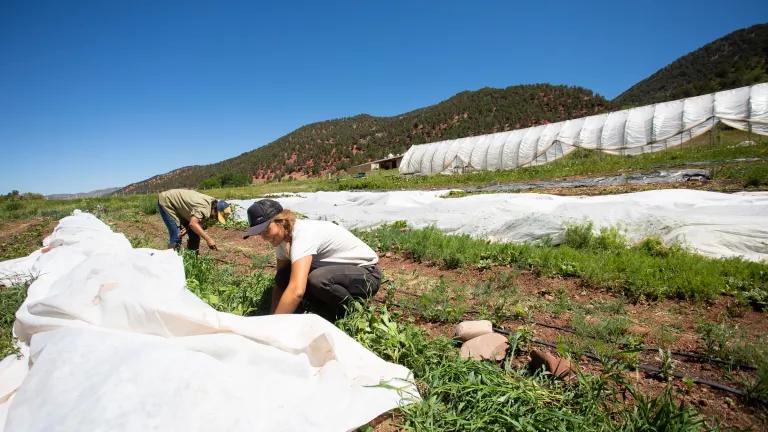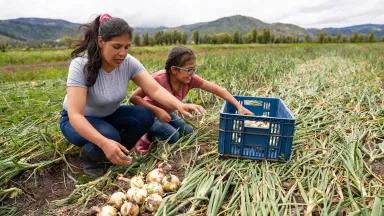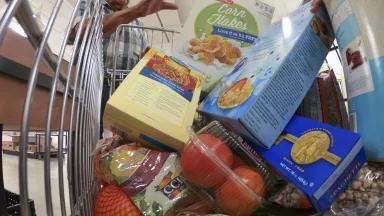If You Care About Climate Change, Then You Care About the Farm Bill
With the upcoming reauthorization of the Farm Bill, we have a chance to shift the U.S. agricultural system from a climate problem to a climate solution.

NRDC’s Arohi Sharma (left) helps farmer Abby Zlotnick tend to crops at Juniper Farm—located on leased public lands owned and managed by Pitkin County, Colorado—where Zlotnick uses regenerative practices in the hoop house and outdoor fields.
About every five years, Congress revises and reauthorizes a legislative package that sets food and farming policy in the United States. The Farm Bill helps determine what we grow and how we grow it, funds programs for farmers as well as food access for low-income families, and establishes environmental protections for natural resources like soil and water. There have been 18 Farm Bills since the first one passed in 1933, and its last iteration in 2018 was a $428 billion investment. The bill has 12 categories, called titles, and they cover everything from agricultural conservation and rural utilities to nutrition and crop insurance. The nutrition title is the largest, receiving more than 75 percent of the bill’s total dollars to fund programs such as the Supplemental Nutrition Assistance Program (SNAP).
Some may not immediately see the environmental and health connection, but “the Farm Bill is one of the most critical pieces of legislation that shapes our food system and its environmental impacts, such as air and water pollution,” says Allison Johnson, a senior attorney in NRDC’s People & Communities Program. “So it's something that every environmentalist should be paying attention to and engaging their representatives on.”
Following the one-year extension of the 2018 Farm Bill in September 2023, Senate and House agriculture committee hearings for the next update will continue, with officials gathering input from the public. For instance, NRDC submitted testimony in Michigan on job growth and economic opportunity and in Minnesota, on a wide range of issues, including regenerative and organic agriculture, water infrastructure, and Farm to School programs.
Climate change, of course, runs through all of these issues. Agriculture is responsible for about 11 percent of U.S. greenhouse gas emissions—an amount higher than the total emissions from all but the 12 most polluting countries in the world. Some big sources of those emissions are concentrated animal feeding operations (CAFOs), with their huge manure lagoons, ruminant livestock like cattle and sheep that literally belch methane (and they do this a lot), and synthetic fertilizers and pesticides, which take large amounts of fossil fuels to produce and which release nitrous oxide into the atmosphere.
Peter Lehner, a former NRDC executive director who now directs Earthjustice’s sustainable food and farming program, says the stakes are too high to let industry call the shots any longer. “We have to get onto the playing field—and we have to get on the playing field with a 30-year perspective.”
Indeed, the $369 billion Inflation Reduction Act, which President Joe Biden signed into law in August 2022, recognizes the relationship between agriculture and climate change. Among other provisions, the act includes $20 billion for climate-friendly agriculture—the largest investment in agricultural conservation funding since the federal response to the Dust Bowl in the 1930s—and $6 billion in relief for farmers and ranchers burdened by debt or discrimination.
The upcoming Farm Bill can build on the momentum set into motion by these investments. Here’s how.

Harvesting Korean mint at Truelove Seeds farm in Pennsylvania, where culturally important seeds are grown by more than 50 small-scale urban and rural farmers who are committed to community food sovereignty, cultural preservation, and sustainable agriculture
Sahar Coston-Hardy for NRDC
Climate-friendly farming
“The connection between climate and agriculture is really beginning to crystalize, and there are many opportunities for our agricultural system to shift from being a climate problem to a climate solution,” says Matthew Kaplan, a senior attorney in NRDC’s Nature Program.
Some of the greatest natural climate solutions lie right under our feet: regenerative and organic farming. The country’s agricultural soils have the potential to store 250 million metric tons of carbon dioxide or its equivalent every year—if we tend to them in the right ways.
With the Farm Bill, Congress could incentivize regenerative practices, such as cover cropping, or planting specific crops like rye and peas with the intention of building soil health. One way to do that is through the COVER Act, which would offer farmers who plant cover crops a $5-per-acre savings on their crop insurance. The Farm Bill could also expand programs such as the Soil Health Demonstration Trial, a 2018 Farm Bill addition that tracks and compensates farmers’ efforts to improve their soil. Lastly, the bill could establish programs to help farmers and ranchers incorporate agroforestry into their operations in order to help make crops—and surrounding lands and waterways—more resilient to climate impacts. To boot, a 2011 study found that growing trees around crops and pastureland, an Indigenous land management practice, could offset up to a third of U.S. carbon emissions each year.
In addition, more support for organic farming could help reduce the use of fossil fuel–intensive fertilizers and pesticides that emit nitrous oxide, a potent greenhouse gas that also harms the ozone layer. NRDC began advocating for the Farm Bill to include support for organic agriculture more than three decades ago, after it exposed the risks that the residues of pesticides like Alar pose to children. Partly in response, the 1990 Farm Bill introduced the national standards for the production and labeling of organic produce that we know today.
Now Congress has the chance to build on a new U.S. Department of Agriculture (USDA) initiative that will expand organic agriculture by providing flexible support for farmers and ranchers during the challenging three-year transition to organic. Organic transition programs help put organic farming and ranching within reach for many who wouldn’t otherwise be able to afford it, and some existing successful programs that train farmers and make organic certification easier could be a helpful model for the next Farm Bill.

Bins to collect food scraps for compost at Union Square Greenmarket in New York City
Food system resilience
Every year, we waste up to 40 percent of our food in the United States—$310 billion worth—and send more than 80 million tons of unconsumed food to landfills and incinerators, or leave it rotting in fields. As it decomposes, the food releases climate-destroying methane. In all, wasted food generates around 270 million metric tons of greenhouse gases every year, roughly as much as the annual emissions from 58 million cars. The 2018 Farm Bill was the first to target food waste, and this time around, we have a chance to expand on those efforts.
Last year, NRDC partnered on a report detailing opportunities for investing in programs that focus on preventing food waste by standardizing date labels, strengthening food donation systems, ramping up efforts like composting, and supporting agency coordination that makes all of this possible. By carefully managing supply chains to reduce, rescue, and recycle the food we would otherwise waste, we can cut emissions while helping those who are food insecure (about 34 million people in the United States in 2021). Such efforts have become increasingly important in the face of a pandemic and climate-fueled extreme weather.
Similarly, transitioning away from industrial animal agriculture to more local and sustainable systems will also help reduce pollution and make communities stronger in the face of future disasters. For instance, hurricanes have flooded the waste ponds of hog farms in North Carolina, causing disturbing amounts of pollution, and early COVID-19 outbreaks in meat processing plants sickened workers and shut down operations, leading to disrupted supply chains. Such events put on display the deep vulnerabilities and dangers of a meat industry that’s dominated by a handful of large companies.
Each year, the vast majority of the country’s livestock are raised in CAFOs, which confine them in close proximity and in stressful, unsanitary conditions. The concentrated waste from these animals not only releases methane and nitrous oxide, pollutes our water, and sickens workers and surrounding community members, but they can also fuel antibiotic resistance. The Inflation Reduction Act removed the requirement for CAFO funding, and the next Farm Bill could provide funding to help producers transition away from the CAFO model, as well as expanding local and regional meat processing to support smaller-scale, regenerative, and organic production.
In the end, working to decentralize supply chain distribution and expand local and regional agriculture could help create a more resilient food system—one that’s better prepared to withstand the impacts of climate change.

Harvesting turnips in a high tunnel at a Choctaw Fresh Produce project farm on the Mississippi Band of Choctaw Indians Reservation
Equity and accessibility
“There’s a lot of interest in and energy around trying to advance a Farm Bill that doesn't continue to skew the playing field in favor of large industrial agriculture or reinforce inequality,” says Johnson. “The bill needs to make sure that smaller-scale and underserved producers are getting a fair share of our public investments in agriculture and that healthy food is affordable and accessible to all.”
Over the course of the 20th century, the amount of Black-owned farmland in the United States fell by at least 87 percent, and today, white farmers own about 98 percent and operate 94 percent of all U.S. farmland. Decades of racial discrimination in USDA lending and programming have pushed many Black, Indigenous, and other farmers of color off of the land and saddled them with debt. In fact, lack of access to land remains a top barrier for BIPOC farmers as well as young farmers (who are overwhelmingly using sustainable practices and concerned about climate change). Funding through the next Farm Bill could help ensure access to land for these growers and help stop others from leaving the job.
Meanwhile, a recent USDA report found that one in every 10 households in the country can’t afford adequate amounts of food. The vast majority of Farm Bill funding goes toward SNAP, a program that fights food insecurity by putting meals on tens of millions of tables across the United States. A letter that NRDC and more than 150 other organizations sent to President Biden and USDA Secretary Tom Vilsack last year noted that the new Farm Bill “must protect and strengthen this program to ensure sufficient resources, merit staffing, and access to nutritious food for all people who struggle against hunger and food insecurity as a result of wealth and income inequities, often driven by systemic racism.”
A farm bill on offense
Climate advocates are determined to change the game and shift away from legislation that has fueled food-related environmental and health problems. Johnson explains that we’ve won many significant victories that have kept important provisions in the Farm Bill, such as support for farm conservation programs, organic agriculture, and protections for pollinators. Now, it’s time to gain more ground and secure a food system that will be safe, equitable, and resilient into the future.
Lehner stresses that there is an urgent need for year-round Farm Bill advocacy—not just once every five years in anticipation of reauthorization. This kind of engagement, he says, is critical as the climate crisis intensifies. “The Farm Bill is very, very important for every environmental issue. We have to start building the framework for change.”
This story was originally published on October 18, 2022, and has been updated with new information and links.
This NRDC.org story is available for online republication by news media outlets or nonprofits under these conditions: The writer(s) must be credited with a byline; you must note prominently that the story was originally published by NRDC.org and link to the original; the story cannot be edited (beyond simple things such as grammar); you can’t resell the story in any form or grant republishing rights to other outlets; you can’t republish our material wholesale or automatically—you need to select stories individually; you can’t republish the photos or graphics on our site without specific permission; you should drop us a note to let us know when you’ve used one of our stories.
We need climate action to be a top priority in Washington.
Tell President Biden and Congress to slash climate pollution and reduce our dependence on fossil fuels.





Greenhouse Effect 101
What Are the Causes of Climate Change?
Industrial Agricultural Pollution 101